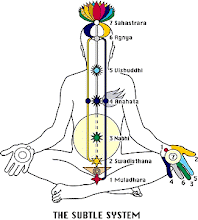Divinesahajayoga
Sahaja Yoga is a unique method of meditation based on an awakening that can occur within each human being. Through this process an inner transformation takes place by which one becomes moral, united, integrated and balanced. One can actually feel the all pervading divine power as a cool breeze, as described in all religions and spiritual traditions of the world.
Saturday, May 09, 2009
Symbol of Shalivahanas

They put up a ‘Gudi’ means a flag and a small pitcher is put on it as a symbol. This pitcher has a particular shape which represents Kundalini. So they were the worshippers of Kundalini and followed it. That is the reason they made this symbol in this way. All those who follow Kundalini put up a ‘Gudi’ in their houses and also put a flag on it as a symbol to welcome the Kundalini and exhibit in a special way. But all these people are moving in the rut. They are doing all these rituals without knowing the cause of it. One should know the reason for doing certain things. What is it? Because the Satvahanas were the worshippers and protector of Kundalini and they started their New Year like that. In the New Year they made their symbol in the form of a small pitcher and the flag put on the stick. But here in this part people do not know about it nor do they celebrate this festival.
(H.H. Shri Mataji, Gudi Padwa Puja (Translated from Hindi)
Palam Vihar, Gurgaon, India, 13.04.2002)
Thursday, April 16, 2009
Wednesday, April 15, 2009
Tuesday, April 14, 2009
Monday, April 13, 2009
Sunday, April 12, 2009
Different patterns of Shri VishnuMaya over Dubai
Different patterns of Shri VishnuMaya over Dubai (esp. Burj Al Arab). A prior announcement of the arrival of world's tallest personality in Love, Compassion, Truth, .... and everything else...... in UAE.
Sunday, September 30, 2007
SahajaYoga 'can help asthmatics'

Severe asthmatics may benefit from yoga A type of meditation based on yoga may ease asthma for some. However, there is little evidence that other relaxation techniques can help. Two studies carried out at the Department of Complementary Medicine at the University of Exeter looked at a variety of techniques. The first compared patients taught to carry out Sahaja meditation with another group using other forms of relaxation, such as "positive affirmation", visualisation and progressive muscle relaxation. Sahaja meditation aims to create a state of "full or heightened mental alertness". The researchers found that after four months, the patients, who had moderate to severe asthma which had failed to respond to conventional drug treatment, showed distinct differences. The responsiveness of the patients' airways was measured, and in the meditation group, responsiveness to asthma medication was noticeably better than those simply carrying out relaxation techniques. The extra effect they experienced was similar to the other group being given an extra dose of medication. The mood of both groups was also assessed - both had improved - but by more in the case of the meditating asthmatics. Quality of life However, there were no noticeable differences in the overall measured "quality of life", or, significantly, in the use of inhalers, reported symptoms or breath strength. Another study carried out at the university reviewed a number of other trials looking at the effects on asthma of several relaxation techniques.
Of 15 trials, two involving progressive muscle relaxation or muscular and mental relaxation showed significant improvements in lung function - but the researchers suggested that the "poor quality" of the research might be harming the chances of reliable answers from the studies. Dr John Harvey, from the British Thoracic Society, said: "Complementary therapy is becoming more popular with patients as they seek to relieve the emotional, as well as physical symptoms of their condition. "Simple relaxation techniques and exercise can help regulate breathing patterns and also improve lung function. "As a result, some asthmatics may find yoga helps them to manage their condition by easing symptoms." However, he added: "The benefits of yoga, or any other relaxation techniques, are additional to the benefits of conventional drug treatment, and it is vital that patients continue to take their prescribed medication." |



